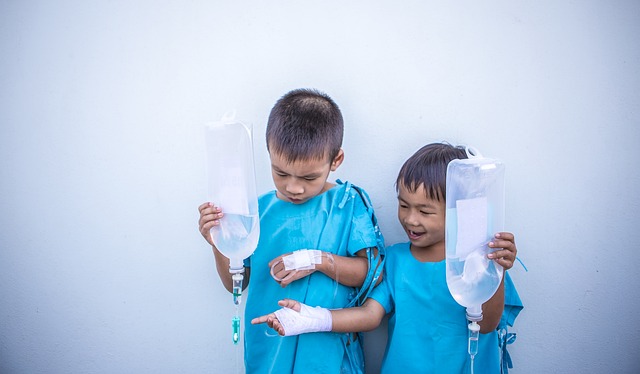
Image Source: FreeImages
Childhood illnesses are a common concern for parents and caregivers. From common colds to more serious infections, it is important to be aware of the symptoms, treatments, and preventive measures for these ailments. In this comprehensive guide, we will explore 10 common childhood illnesses and provide valuable insights to help you navigate through them.
Table of Contents
- Sore Throat
- Skin Infections
- Stomach Flu (Gastroenteritis)
- Bacterial Sinusitis
- Common Cold
- Ear Infections
- Bronchitis
- Respiratory Syncytial Virus (RSV)
- Hand, Foot, and Mouth Disease
- Conjunctivitis
Let’s dive into each of these childhood illnesses, their symptoms, treatments, and preventive measures.
1. Sore Throat
A sore throat is a common childhood illness characterized by pain, itchiness, and difficulty swallowing. It is often caused by viral or bacterial infections, such as strep throat. The typical symptoms of a sore throat include pain, rough or itchy throat, difficulty swallowing, voice changes, fever, cough, and nasal congestion[^1^].
Treatment: Consult a healthcare professional for a proper diagnosis. Antibiotics may be prescribed for bacterial infections. It is important to complete the full course of antibiotics to prevent complications like rheumatic fever. Most viral sore throats resolve within 7 to 10 days without specific treatment[^1^].
Prevention: Encourage good hand hygiene, such as regular handwashing, to prevent the spread of infections. Teach children to cover their mouths and noses when coughing or sneezing to reduce the transmission of pathogens[^1^].
2. Skin Infections
Children are prone to various skin infections caused by bacteria, fungi, viruses, or allergies. These infections can manifest as itchy, reddish skin, painful rashes, inflammation, fever, or skin eruptions[^2^]. The specific treatment for skin infections depends on the underlying cause and severity.
Treatment: Pediatric dermatologists may examine the skin and request a skin sample or culture to determine the exact cause of the infection. Treatment options include topical or oral antifungals, antibiotics, or antivirals. Most skin infections respond well to treatment, and the lesions usually disappear within a few weeks[^2^].
Prevention: Promote good personal hygiene practices, such as regular bathing and keeping the skin clean and dry. Teach children not to share personal items like towels or clothing to minimize the risk of transmission. Additionally, encourage them to avoid contact with irritants or allergens that may trigger skin infections[^2^].
3. Stomach Flu (Gastroenteritis)
Gastroenteritis, commonly known as stomach flu, is an infection of the intestines. It is characterized by symptoms such as fever, cramping, nausea, vomiting, and occasional headaches or muscle pains[^3^]. The most common causes of gastroenteritis in children are viruses, such as rotavirus or norovirus.
Treatment: The primary focus of treatment for gastroenteritis is to prevent dehydration. Encourage the child to drink plenty of fluids and provide a balanced diet of non-spicy foods. In some cases, anti-diarrheal medications may be prescribed, but it is essential to consult a healthcare professional before administering any medication[^3^].
Prevention: Emphasize proper handwashing techniques, especially before meals and after using the toilet, to reduce the risk of infection. Ensure that food is prepared and stored hygienically to prevent contamination. Vaccination against rotavirus is also available and can provide protection against severe gastroenteritis[^3^].
4. Bacterial Sinusitis
Bacterial sinusitis is the inflammation of the sinus lining caused by bacteria trapped in the sinuses. It often occurs after a viral upper respiratory infection. Symptoms include thick yellow nasal discharge, prolonged fever, headache, light sensitivity, eyelid puffiness, and irritability[^4^].
Treatment: Bacterial sinusitis is usually treated with antibiotics for a duration of ten days or more. It is important to complete the full course of antibiotics as prescribed by a healthcare professional to effectively clear the infection[^4^].
Prevention: Encourage good respiratory hygiene, such as covering the mouth and nose when coughing or sneezing, to prevent the spread of bacteria. Teach children to avoid close contact with individuals who have respiratory infections to reduce the risk of contracting sinusitis[^4^].
5. Common Cold
The common cold is a viral infection that affects the upper respiratory tract. Rhinoviruses are the most common pathogens responsible for causing colds. Symptoms include a runny or stuffy nose, sneezing, sore throat, coughing, headache, mild fever, and general discomfort[^5^].
Treatment: There is no specific cure for the common cold, as it is caused by a viral infection. Treatment focuses on managing symptoms and promoting rest and hydration. Over-the-counter medications may be used to alleviate symptoms like fever or nasal congestion, but it is essential to follow age-appropriate dosages and guidelines[^5^].
Prevention: Encourage regular handwashing, especially before meals and after coughing or sneezing. Teach children to avoid close contact with individuals who have colds to minimize the risk of transmission. Additionally, promote a healthy lifestyle with a balanced diet, regular exercise, and adequate sleep to strengthen the immune system[^5^].
6. Ear Infections
Ear infections, also known as otitis media, are common childhood illnesses characterized by inflammation and infection of the middle ear. They can be caused by bacterial or viral infections and are more prevalent in children due to their anatomy. Symptoms include ear pain, fever, irritability, difficulty sleeping, and tugging at the ear[^6^].
Treatment: Treatment options for ear infections depend on the severity and cause. Antibiotics may be prescribed for bacterial infections, while viral infections usually resolve on their own. Pain relievers, such as acetaminophen or ibuprofen, can be used to alleviate discomfort. It is important to consult a healthcare professional for an accurate diagnosis and appropriate treatment[^6^].
Prevention: Encourage good respiratory hygiene to reduce the risk of upper respiratory infections, which can lead to ear infections. Avoid exposing children to secondhand smoke, as it can increase the likelihood of developing ear infections. Additionally, promote breastfeeding, as it can provide some protection against ear infections[^6^].
7. Bronchitis
Bronchitis is the inflammation of the airways in the lungs, which leads to coughing, soreness in the chest, fatigue, headaches, body aches, and a sore throat. Most cases of bronchitis are caused by viral infections that often occur after an upper respiratory infection[^7^].
Treatment: Viral bronchitis usually resolves on its own with rest, hydration, and over-the-counter medications to alleviate symptoms. Antibiotics are not effective against viral infections and are only prescribed in specific cases, such as when there is a secondary bacterial infection[^7^].
Prevention: Encourage good respiratory hygiene, such as covering the mouth and nose when coughing or sneezing, to reduce the spread of viruses. Avoid exposing children to environmental irritants, such as tobacco smoke or air pollution, which can increase the risk of developing bronchitis[^7^].
8. Respiratory Syncytial Virus (RSV)
Respiratory syncytial virus (RSV) is a common viral infection that primarily affects the respiratory system. In most children and adults, RSV causes mild cold-like symptoms, including fever, coughing, runny nose, and sneezing. However, it can be more severe in young infants and older adults, leading to inflammation in the airways and potentially pneumonia[^8^].
Treatment: Treatment for RSV infection focuses on managing symptoms and providing supportive care. This includes ensuring adequate hydration, using nasal saline drops to relieve congestion, and using a cool-mist humidifier to ease breathing. In severe cases, hospitalization may be required for respiratory support[^8^].
Prevention: Practice good hand hygiene, especially before handling infants or young children. Limit exposure to individuals with respiratory infections, as RSV is highly contagious. It is also recommended to avoid smoking around infants and to keep their environment clean and free from irritants[^8^].
9. Hand, Foot, and Mouth Disease
Hand, foot, and mouth disease (HFMD) is a viral infection commonly affecting infants and children. It is highly contagious and is characterized by a rash or blisters on the hands, feet, and mouth. Other symptoms may include fever, sore throat, and a general feeling of discomfort[^9^].
Treatment: Treatment for HFMD focuses on relieving symptoms and promoting comfort. Over-the-counter pain relievers can be used to alleviate fever and discomfort. Maintaining good oral hygiene and providing soft foods or liquids can help ease swallowing difficulties caused by mouth sores[^9^].
Prevention: Practicing good hygiene, such as frequent handwashing, can help reduce the risk of HFMD transmission. Avoid close contact with individuals who have active symptoms of the disease. Disinfect commonly touched surfaces and objects to minimize the spread of the virus[^9^].
10. Conjunctivitis
Conjunctivitis, commonly known as pink eye, is an inflammation of the conjunctiva, the thin membrane that covers the whites of the eyes and the inner surface of the eyelids. It can be caused by bacteria or viruses and is characterized by redness, discharge, itchiness, and swelling in one or both eyes[^10^].
Treatment: Treatment for conjunctivitis depends on the underlying cause. Bacterial conjunctivitis is usually treated with antibiotic eye drops or ointments, while viral conjunctivitis typically resolves on its own without specific treatment. Allergic conjunctivitis may require antihistamine eye drops to relieve symptoms[^10^].
Prevention: Encourage good hygiene practices, such as avoiding touching or rubbing the eyes, and frequent handwashing to prevent the spread of conjunctivitis. Teach children not to share personal items like towels or eye makeup to minimize the risk of transmission[^10^].
Remember, this guide provides an overview of common childhood illnesses. If you suspect that your child may have any of these illnesses, it is important to consult a healthcare professional for an accurate diagnosis and appropriate treatment. By being proactive in preventing and managing childhood illnesses, you can help ensure the well-being of your child.
Conclusion
Childhood illnesses are a common part of growing up, but with proper knowledge and understanding, parents and caregivers can navigate through them effectively. By recognizing the symptoms, seeking appropriate treatment, and implementing preventive measures, we can promote the health and well-being of our children. Stay informed, practice good hygiene, and consult healthcare professionals when needed to ensure the best care for your child’s health.




